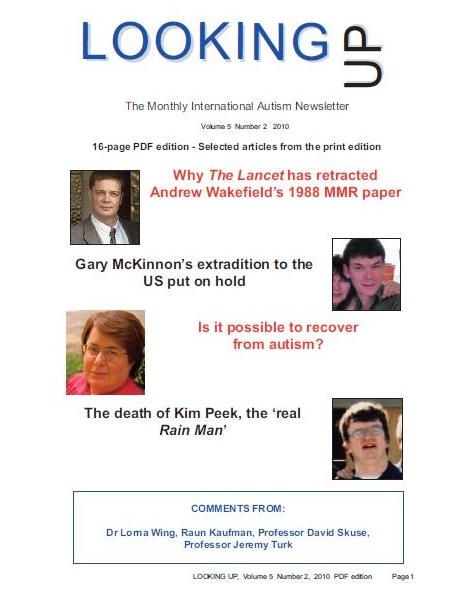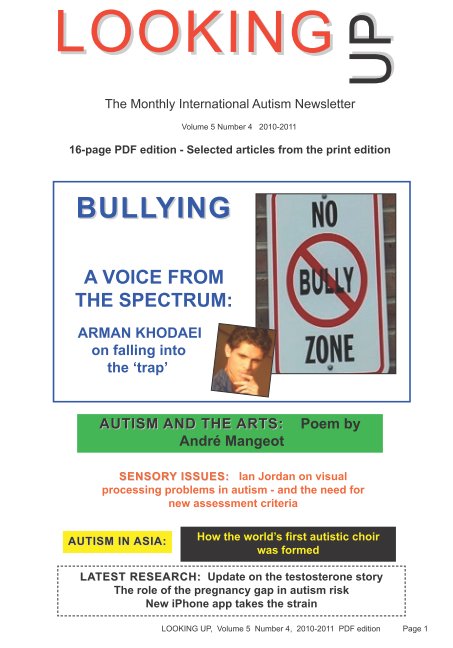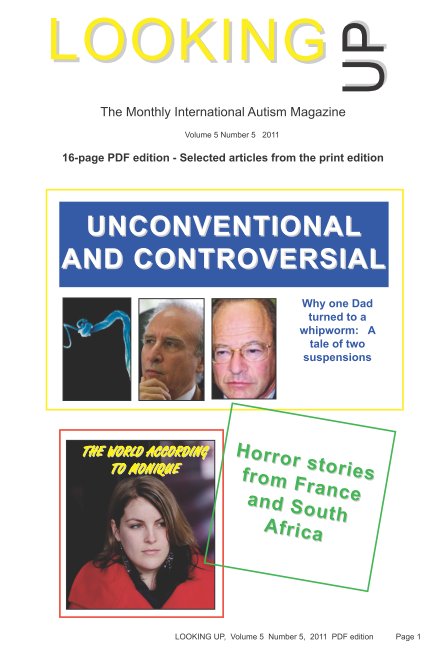Looking Up, 16-page English PDF Edition, Back Issues and Current Issue

|

|

|

|

|

|

|

|
| Home page | Subscribe (print edition) | Selected articles | Our publications | Our mailing lists |
| PDF edition | Subscribe (PDF edition) | Back issue contents | Autism books | Contact us |
From Volume 5 Number 4 (print and PDF editions)
CARDIFF, Wales: A Welsh Minister instrumental in developing the national autism strategy for Wales and in the establishment of the University’s Wales Autism Research Centre has seen at first hand how the centre is already having an impact on people living with autism.
Gwenda Thomas AM, Deputy Minister for Social Services, has met with the academics, charities and funders who have been working together to drive forward vital research into autism during the Centre’s first Open Afternoon since its launch in September 2010.
A particular theme of the afternoon was the relationship between research impact and discovery. The Centre, which is based in the School of Psychology, is working to help ensure that scientific research has a positive impact on the lives of people with autism and families affected by the disorder, while at the same time ensuring that scientific understanding can continue to make advances through the creation of new knowledge.
Gwenda Thomas said: “I am delighted to have visited the Wales Autism Research Centre at Cardiff University and to meet such a passionate and inspirational team who I know are doing good work to support the needs of those with autistic spectrum disorder (ASD). This innovative research centre is an excellent example of Wales doing something positive to address the issue of ASD and, coupled with the Assembly Government policy commitments to support individuals with autism, we should be proud that we are in some way helping to improve their quality of life and that of their family and carers.”
The visit included an update on what has been achieved in the Centre’s initial phase of development, and insights into latest researchb projects with contributions from collaborating clinicians, educational professionals and parents of children with autism. The Minister was updated on how the Centre is carrying out new research on children’s diagnosis and intervention. She also heard how the team is contributing to a training programme for teachers in mainstream schools in Wales, and the Centre’s work with neuroscientists at the University’s pioneering Cardiff University Brain Research Imaging Centre (CUBRIC) to learn more about the biological basis of autism.
Professor Susan Leekam, Chair of Autism at Cardiff University and Director of the Wales Autism Research Centre, said: “The Open Afternoon was an opportunity to thank Mrs Thomas, and the charities that have supported us. In the last year, we have also been welcomed by a community of collaborators, including professionals and parents who work and live with autism. The afternoon also provided the opportunity to thank this community for working with us and helping to advance autism research.
“Research impact into educational and clinical practice is important but it is not enough. We still need further new discovery and new knowledge to grow in order to move the field forward. By carrying out a wide range of projects in areas ranging from neurobiology to diagnosis, intervention and service provision, we are working towards that goal.”
The Wales Autism Research Centre was established with the support of the charities Autism Cymru and Autistica, and from the Welsh Assembly Government as part of its Autistic Spectrum Disorder Strategic Action Plan.
The Welsh Assembly Government’s Strategic Action Plan for Autism Spectrum Disorder is believed to be the first of its kind anywhere in the world. Uniquely, the Centre works with practitioners and government policy makers within this action plan to integrate research evidence with policy and practice and is rapidly developing an international reputation with many collaborators working within academic, government, clinical and education settings, in Wales, the United Kingdom and internationally.

|

|

|

|

|

|

|

|
| Current 40-page print edition issue | |||||||||||||||
|---|---|---|---|---|---|---|---|---|---|---|---|---|---|---|---|

|
| ||||||||||||||
| PRINT EDITION BACK ISSUE CONTENTS AND FRONT COVERS | ||||||||||||||||||||||||||
|---|---|---|---|---|---|---|---|---|---|---|---|---|---|---|---|---|---|---|---|---|---|---|---|---|---|---|
| VOLUME 1, Number: | 1 | 2 | 3 | 4 | 5 | 6 | 7 | 8 | 9 | 10 | 11 | 12 | VOLUME 2, Number: | 1 | 2 | 3 | 4 | 5 | 6 | 7 | 8 | 9 | 10 | 11 | 12 | |
| VOLUME 3, Number: | 1 | 2 | 3 | 4 | 5 | 6 | 7 | 8 | 9 | 10 | 11 | 12 | VOLUME 4, Number: | 1 | 2 | 3 | 4 | 5 | 6 | 7 | 8 | 9 | 10 | 11 | 12 | |
| VOLUME 5, Number: | 1 | 2 | 3 | 4 | 5 | 6 | 7 | 8 | ||||||||||||||||||
| You can find our PDF EDITION CONTENTS AND COVERS on our PDF EDITION BACK ISSUES PAGE | ||||||||||||||||||||||||||
| Home page | Subscribe (print edition) | Selected articles | Our publications | Our mailing lists |
| PDF edition | Subscribe (PDF edition) | Back issue contents | Autism books | Contact us |